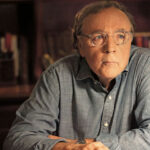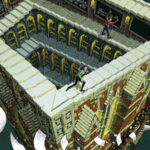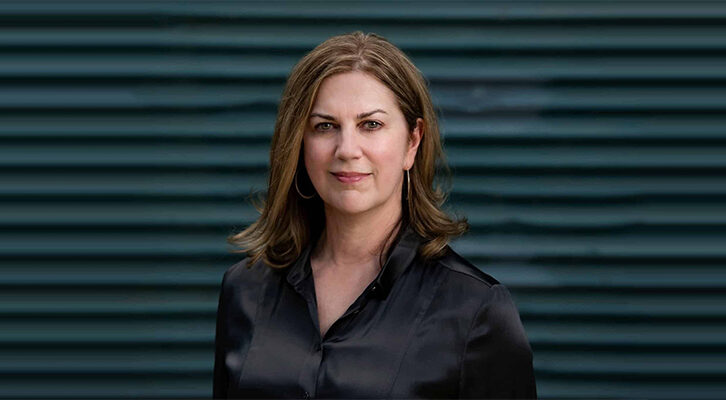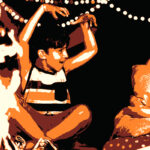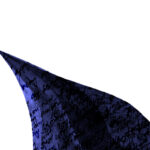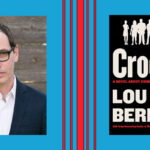William Kentridge’s Provisional Memory, Provisional Words
15 Thoughts from the Master Animator
Last week, acclaimed South African artist William Kentridge delivered the December 2018 Message from the Library, Brooklyn Public Library (BPL)’s commissioned public lecture series. Past speakers were David Grossman and Edwidge Danticat. Kentridge’s lecture follows below. For more information on BPL’s literary and cultural programming, please visit www.bklynlibrary.org/bpl-presents.
The Smell of Old Books
I draw in old books. Sometimes I draw in the books themselves, but generally speaking I dismember the books, pulling the cover from the glue holding the spine, slicing through the string that is holding the bound signatures and separating the pages. It’s an undoing of what Dante describes at the end of Paradiso when all the pages and all the leaves of the Cumaean Sybil fly through the air and are gathered into one single book, a chaos of knowledge forming itself into a coherence. Although I cut the books mainly for the ease of drawing on the sheets of paper and for the ease of photographing them later into an animated film, it is also a dismembering of order, a disordering of a coherence.
What are the books I choose? In general they are old dictionaries, they are encyclopedias, books that are superseded by newer editions. In general no rare books, no particularly valuable books. They are books found living the end of their lives on the shelves of second-hand and antiquarian bookstores. The books are chosen partly for the association of list-ness in them. Encyclopedias and dictionaries are lists and demonstrate an ordering of knowledge in one form or another, by subject, by alphabet, into a coherence. The drawing on top of them is always a re-inscribing of a different kind of thinking on top of the words of the book.
But the books are usually chosen for the quality of their paper and for their typography and density of ink. A very rough tooth if I’m going to draw in charcoal, a slightly smoother surface if I’m going to use an ink wash and I want to precipitate out the different intensities of ink washes. The amount of size that’s in the paper, how absorbent it is. Sometimes I need a shiny surface if I want to wipe a charcoal mark off with a simple brush of my hand or a chamois leather cloth. Sometimes they are chosen for their size and proportion, how an open book fits into the format of a film frame. And the drawings in the books generally are turned into extended flip books. That is to say variations on themes, each page being a different frame.
The Prisoner in the Books
What is it to have all these different pages, this multitude of different images that one has when one dismantles a book? I do a drawing of a man or an animation of a man walking backwards and forwards. It is a zoetrope, that is to say the movement gets to one position and starts again where it left off, so it can become an endless repetition. The man in the book, just as I am walking in the studio and stride from one side of the page to the other, turns and returns even as the pages are moving. It’s a way of making an extended flip book, not the one-and-a-half seconds of the usual forty-six slightly stiff pages of a flip book. It can turn into a seven- or eight- or twelve-minute film, many thousands of pages.
Associations spread out from this. The pages become two things. They become the frames of a film. So in the same way that a roll of celluloid film with its thousands of frames is a way of transforming time into physical weight, these pages of the book also encapsulate time as if each page is a day in the life of a prisoner in the book who will never escape the book. Whichever page you open, there you are.
One is always aware that even as one looks at a book there’s this duality. There are the words of the text and their relationship to the history of the world coming towards you, and as they do, sitting next to your reading faculty, are all the associations that the words you’ve read bring to mind. And the sense of the book is not deep inside it, but hovers somewhere between the book itself and us, the readers and our projections.
Thinking in Material
There always needs to be a connection between the topic that is being addressed and the material in which one thinks about it. This may be charcoal, it may be ink, it may be the gesture of an actor, but always this has to be one of the ways of arriving at thoughts rather than simply illustrating thoughts that one already has. If one is talking about dismantling books, one is talking about that not just as a technique but also as a way of thinking about the world. Thinking about the world as collage, as disordered fragments being brought together, reordered, making a new alphabet of the pages of the dictionary, the half-images on one page connected to the half-image on another.
This act of reordering, dismembering and reordering is always the essential activity of the studio. The world is invited into the studio, it is taken apart into fragments, the fragments are reordered and then sent back out into the world as a song, a drawing, a piece of theater. This dismantling is not simply a technique or a strategy, but also can be a revelation of the instability of knowledge in the world, its provisionality. The collage and the reordering becomes the subject itself.
Reading the White Spaces
I come from a family of lawyers. Both my parents were lawyers, my grandmother was the first woman advocate in South Africa, and my maternal and paternal grandfathers were both lawyers. It became essential for me to try to find a way of arriving at and making an understanding of the world that was impervious to the techniques and arguments of legal cross-examination.
Years later I discovered that within the Jewish liturgical tradition, there’s both the strand that was very familiar to my family (in its secular form) of taking the laws and dissecting them minutely and finding all the possible interpretations of particular words through a forensic examination of each phrase and argument. Later I discovered that there is also a style of Jewish prayer, a much more ecstatic one, that is less concerned with the details of the law but finds a more direct connection to the religious world (in their words of course, to God).
And that for these people, a section of the Hasidic community, the spaces between the letters, between the lines, the white spaces were as useful in promoting this devotion, this connection to the other world as were the black printed letters of the press. And I thought, “Oh, all my life without knowing there’s been this Hasid in me that is interested in what happens on and beyond the words.”
The world is invited into the studio, it is taken apart into fragments, the fragments are reordered and then sent back out into the world as a song, a drawing, a piece of theater.Pause
One has to understand there is a strange relationship of words to the world. We cannot trust them. The printed book gives a kind of spurious authority to this relationship. In common speech we are much more aware of this difficult and tenuous connection. Do the words have a direct connection to the objects in the world that they name, or are they simply a series of observations that float above the world and invite us to make connections between them and the world? And so in everyday speech, in this talk I’m doing as I walk around the studio, this talk that I am doing now, I realize I’m gesturing with my hand, trying to impress this empty chair or that table or the tripod standing in the corner there, of the rightness that I’m saying. A whole series of gestures, of shirt pulling, of tugging, of finger waving, of arms waving from side to side, of fists moved in emphasis, trying to connect, trying to persuade these inanimate objects of the connection of what I am saying to the world.
There are the gaps between the words which are pauses, breaths, change of volume, of emphasis, which are devices outside of the specific words and their argument to make the connection to the world. We are always implicated in what we hope will be an objective knowledge. We’re busy subdividing and taking the world apart here. We’ve got the words, we’ve got the gaps between the words, we’ve got the materiality of the ink, the specific paper, we’ve got the biography of the reader meeting it. What appeared to start off as a simple book has shattered into all these different strands of possible meaning. The certainty of the book changes into something that is provisional.
*
Fümms bö wö tää zää Uu,
pögiff ,
kwii Ee.
Dedesnn nn rrrrr,
Ii Ee,
mpiff tillff too,
tillll, jüü Kaa
rakete rinnzekete
rakete rinnzekete
rakete rinnzekete
rakete rinnzekete
rakete rinnzekete
rakete rinnzekete
Beeeee
bö
Dedesnn nn rrrrr,
Ii Ee,
mpiff tillff too,
tillll, jüü Kaa
fümmsböwötää
fümmsböwötääzää
fümmsböwötääzääUu
fümmsböwötääzääUu pögiff
The Young Boy
That’s a small fragment from Kurt Schwitters’s Ursonate, where words are removed and what you have is simply the effect of the activity of speaking. Compare this to Svetlana Alexievich in her extraordinary series of books which are transcripts of oral recordings of participants in different events in Soviet history. She writes of a young soldier, or she doesn’t write, she records someone talking about a young soldier in the Soviet-Afghan war in the 1970s. “The young boy took a long time to die and as he lay there he said the words for everything his eyes came across, just like a child who is just learning to speak. Sky. Mountain. Tree. Bird. Haversack.”
Here we have language at its most basic, in extremis, trying to tie the word to the world. Somewhere between the two—between Svetlana Alexievich’s young boy and the Ursonate of Kurt Schwitters with all its grunts, pauses, gestures and sounds—we operate with how our language ties us to the world and enables us to make meaning both of the world and ourselves.
On Provisionality, Number One
One can look at the world as either fact or process. In a photograph, one has a fact. Here is the table, a wooden sculpture stand, there is the chair, there is the tripod, here is a book on the table. You take a photograph and these are the facts of the studio. Or one could make a film, and think of all of this as provisional, as one frame in a string of frames, with a history both backwards and forwards. Run the film backwards: the book is unbound, the pages are uninked, the blank pages return to the wood pulp from which they were made, into the planks which have been shredded, back into the tree. Run the tree backwards: the tall branches shrivel and get smaller, the trunk gets thinner and lower, it becomes a sapling and the sapling disappears back down under the earth into its acorn. Or to run the film from the present fact forwards, it expands in the opposite direction: the book no longer on the shelf, the book on the pavement, the book in the fire, the smoke, the ashes. Now the book is seen as one moment in this process of mutation.
On Provisionality, Number Two
This physical provisionality also alerts us to other kinds of provisionalities. The certainty of knowledge being a moment of coherence amongst a sea of possible other senses and meanings. It alerts us to the precarious victories we thought solid and established. Whether they’re victories of civil rights, victories of democracy, victories of rationality, we understand how fragile they are and that they were wrested out of ignorance, superstition, bigotry, and have a moment of flowering. But there’s ahead of them also the enormous danger of them disintegrating back into the fire, into the ash, into the smoke. The material is always, at least for an artist, the only way to think about the immaterial.
The Weight of Words
There’s a deep reassurance in the weight of a book in one’s hands, the comfort of the book remembering for us. There are some people fortunate enough to remember all the plots, all the characters of all the books they have ever read, but for those of us who are not on this memory spectrum whatsoever, there is a reassurance in the books that sit on your shelf silently holding their breath and keeping that knowledge and those memories for you. So that if at a sudden moment you think of a name, a line you want to find, you can walk to the bookshelf, reach up, and remember that about two-thirds of the way through the book, on the top right-hand corner somewhere, sits this particular fact that you want. And the book will be there ready to produce it.
If the book is not there—your hand reaches for it and there’s no book of that name on that section of the shelf—or you find the book and the page that should have that text, on the top right-hand corner, but it does not have it, one feels as bereft as when you think there’s that last bar of chocolate and reach for it and it’s not there, though your tongue is already salivating in anticipation of what will come. And if you discover this line in fact is on the bottom left-hand corner of the page, one feels the book has betrayed you, or at least tricked you, rather than your memory.
The Epigenetics of Memory
There is a way in which the shelves of books around one are a long-term self-portrait. One of course can do a negative self-portrait of all the books that one hasn’t read, and a reproachful self-portrait of all the books which you’ve actually gone to the trouble of buying and are sitting on your shelves or in piles next to your bed, that have also not been read. Possibly there is a third category, apart from the books you’ve read and the books you have intended to read. These are books that you’ve acquired, as gifts or through purchase, which you’re very happy to have on your shelves even though you know it’s completely unlikely you will ever open them or read them.
The book is similar to a shopping list, which remembers for you. This has to do with the physicality of the specimen. I go to the shelf, take a volume at random: Jeppe. Mining on the Witwatersrand, 1946. In contrast to this, this walk around the studio makes me think of the invisibility of the digital. What a relief that Kindles, which were going to take over the world, are fading, or at least are marginal. Much as people thought that the microwave oven would render all other kinds of cooking obsolete and we now know that it’s simply a small, useful adjunct in the kitchen for heating leftover dinners and warming milk for the baby.
This is not just a Luddite pleasure in the materiality of the book, but also an anxiety about the invisibility of the world of Photoshop, the immateriality of drone warfare, which are obviously connected, of the ease and no cost of transforming the world. There’s something about the typed-over typescript, about the yellowing Sellotape and roughly cut pages which have been cut and pasted together, which shows in its material form a process of thinking that is tangible—change has to be fought for. This is rendered invisible in digital format. The cost of change disappears.
Starve the Algorithm
There’s no doubt a fetishism in this object of the book I’m holding onto, but sometimes we have to protect our fetishes. As Groucho Marx remarked, “Outside of a dog a book is a man’s best friend, inside of a dog it’s too dark to read.” There is something of the talisman of the ink, of the paper, of the sound of the page. There’s no doubt that the algorithms, the Google Search are infinitely more efficient than strolling along the shelves of a library imagining which book you should pull out.
There is also an institutional fetishism of books. Some years ago I was in Oxford, in one of the beautiful libraries of one of the colleges, filled with stacks of 15th century books of the doings of different Franciscan societies and other orders of monks. The library tables were all filled with students, there was not one single book visible on any of the tables, only computers. And I asked the librarian, surely I could take at least one of these books to make drawings in it. What were the chances of anyone ever opening one of those books again? But unfortunately my pleas fell on deaf ears. I will not even attempt to make the same request here in this library.
But there is something of the peripheral thinking and peripheral vision of walking down a stack of shelves that we miss. And we must also of course know that the idea of all the thousands of solutions and results that Google makes to every object we search for is a fiction. We put in a subject and 17,400,932 answers are given to that question, but we know that 99.99 percent of people consulting that topic will read the first three items, and the other 17,400,932 are redundant, are a kind of showy window dressing that’s never going to be checked up on.
In this, let me immediately explain my culpability. If I’m looking for images of Italian gas masks from the First World War, in previous years I or an assistant would have gone to the library and trawled through books on the First World War hoping to come across one or other grainy photo of a gas mask that may be Italian from that period. And now of course you hit the button and there are 43,000 images of Italian gas masks. But what is it to try to resist the algorithm? To say within the inefficiency we need to find a place for ourselves? Because it is not just knowledge or images we are finding, but also understand that these images are part of who we are. And the images and inefficiencies and physical weight of the books tie us to the world in a more direct and immediate way than these invisible technologies.
If the Good Doctor
A few years ago in Johannesburg I founded a small art center called the Centre for the Less Good Idea, which brings together different artists, musicians, poets, video-makers, writers, who work on different projects together or develop their own projects, done on the basis that it is in the process of work itself that ideas emerge. Somewhere in the physicality of making the drawing, of the conversation between the dancer and the film-maker, of seeing what this particular sound does to that image as you watch it in the world, somewhere amongst this chaos, ideas emerge from the margins, from the periphery, and inform or transform the initial idea.
This is a strategy for working across mediums. But it is also a way of constructing a safe space for uncertainty. The energy it has generated for participants in the project is extraordinary. There have been some very unremarkable pieces made at the Centre, there’s no doubt about that. But there have been some beautiful pieces that would not have arrived if participants had had to start with a proposal, a proposition, an understanding of what they wanted to do at the beginning.
The name of the Centre comes from a Tswana proverb: “If the good doctor can’t cure you, find the less good doctor.” It is a strategy for making performances and art, but it also has to do with a belief that the grand ideas, the grand certainties are always accompanied by violence and authoritarianism. Every large idea has let us down and is accompanied by invading armies. Our only hope is to try to find ideas at the margins, small provisional ways of working—and in this way, make our way through the morass of the contemporary world.
I think it is not insignificant that this center is located in my hometown, Johannesburg, which has always only made sense of itself and the world through a mixing of different traditions and identities. Of course in South Africa the fight against apartheid was in many ways an attempt to fight against the imposition of identity by apartheid laws.
In Praise of Bastardy
Johannesburg is a young city, only a 130-years-old or so. Its population has always come from outside of the city—from Mozambique, from KwaZulu Natal, from Lesotho, from the far reaches of the country. Miners arrived from Cornwall, traders from Gujarat, people fleeing pogroms in Eastern Europe. It is made up from these radically different groups of people. Obviously in Johannesburg history has allocated people to deeply stratified and separated societies of privilege and domination. But nonetheless, it has been a vital example of what it is to think and to construct something from the edges of a tradition rather than from deep inside it.
Mahatma Gandhi, who is probably our second most famous citizen, lived in Johannesburg for 20 years. He was a young lawyer trained in Britain and came to Johannesburg to look after the interest of Gujarat traders who’d settled in South Africa. During his period in South Africa he developed his political philosophy that he carried through the rest of his life, and that led to the different forms of passive resistance and protest that eventually resulted in Indian Independence.
He had arrived in South Africa as an English-trained barrister, very much deracinated from his Indian roots. He was brought back to his Indian tradition not by his parents, not by studies that he’d done in India, but by Johannesburg Jewish architects showing him works of Ruskin, the English aesthete whose work was indebted to Madam Blavatsky and the theosophists who had used a mistranslated, badly understood version of the Bhagavad Gita and Indian mysticism, and talking to the dead, to arrive at their philosophy. Gandhi came back to understanding Satyagraha not through a deep identity with India, but through this other bastardized route, through the peripheral thinking and the chance meetings of all these other strands of looking at the world.
I’m caught up in this bastardy, in this paradox of bastardy. On the one hand loving the stability of those shelves, of tomes in the stacks below or the library in my house across the garden. On the other hand, taking them apart, using them as a scavenger, as a hyena, dismantling and dismembering. Hoping for moments of elucidation, for sparks to jump from one idea to another so that one can reach a point, an image, an idea one has not anticipated. In the belief that the paradox, the contradiction, the ideas that are sitting in the margin are not just there as mistakes, as aberrations in our understating of the world, but are in fact central to it. Believing in the mistranslation.
Let Us Try For Once
The absurd drama of Gandhi’s history is not a mistake, it’s how we have to be in the world. The prisoner in the book striding backwards and forwards across the pages as I’ve been striding across the length and breadth of the studio while recording this talk to the silent studio . . . (Not so silent. In fact, the bright sunshine when I started talking has given way to the rumbling of thunder as a huge storm approaches Johannesburg, and we will have the great relief of rain in the next 40 minutes). The prisoner in the book walking backwards and forwards, what does he wait for? He waits for the page to fall out, for the pages to separate, for a new page to come in, for some new thought to take him out of the rhythm in which he is stuck, for a new page to arrive in front of him on which in 20-, in 64-point bold type is written, “Let us try for once not to be right.”





